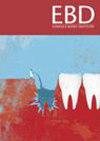Tooth vitality and periapical healing: is Biodentine at par with MTA in regenerative endodontics?
IF 2.3
Q3 Dentistry
引用次数: 0
Abstract
The study is a prospective, double-blinded randomised control trial that compares the mineral trioxide aggregate (MTA) and Biodentine as the pulp space barrier material after induction of a periapical blood clot by over-instrumentation for endodontic regeneration in single-rooted mature permanent anterior tooth (closed apex) with apical periodontitis (periapical pathology of more than 3 mm) and having necrosed pulp. A total of 36 patients were included in the study and after randomisation were allocated equally to both the groups out of which 31 patients returned for follow-up over an 18-month period. The treatment protocol consisted of two separate appointments. At the first appointment, a standardised and custom-made radiographic guide was prepared for each patient to ensure uniformity and repeatability of the radiographs at subsequent follow-up visits. This was followed by access to the pulp chamber and biomechanical preparation of the single canal up to master apical file size. The irrigant used in each case was 1.5% sodium hypochlorite and also calcium hydroxide intracanal medicament was placed during this visit. The interval between the two appointments was not fixed and depended on the patient’s symptoms following the first visit; however, the maximum allowable time frame was set at 3 weeks. During the second visit after irrigation with 17% ethylenediaminetetraacetic acid (EDTA) over instrumentation was done to induce bleeding that was allowed to fill the canal. The clot was stabilised by collagen plug and the pulp space sealer (either MTA or Biodentine) was placed below the cementoenamel junction following which composite restoration was done. The radiographs were taken before the treatment, after both the appointments and at 6, 9, 12 and 18 months subsequently by a single experienced examiner. Pre-operatively, a periapical index score (PAI) was given to each case and the sensibility test was performed at 6, 12, 18 months postoperatively using an electric pulp tester (EPT). Participants were recruited from the Department of Endodontics outpatient clinic. The patients were aged between 10-35 years and had no systemic conditions. For inclusion in the study, participants were required to have mature anterior tooth (single root canal) with closed apex associated with apical periodontitis and necrotic pulp having periapical radiolucency of more than 3 mm on the radiograph. Patients suffering from periodontitis (ensured by periodontal probing) and those having developmental anomalies of the teeth were excluded from the study. The normalcy of the data was assessed by Shapiro-Wilk test. Continuous data was analysed by Mann Whitney U test and the categorical data was analysed by Chi-square test and Fisher’s exact test. With the level of significance set at 0.05. Firstly, the author presented the overall healing of the periapical lesion from Fisher’s exact test, which showed that after 18 months, out of 31 patients, 21 cases (67.7%) had completely healed and 10 cases (32.3%) showed signs of healing and no case remained unhealed. The difference between the Biodentine and MTA was non-significant as derived from the Chi-square test for comparison of postoperative lesion sizes score at 18 months postoperatively. Secondly, based on EPT, the author presented the regain of tooth sensibility from Fisher’s exact test which shows that out of 31 cases, 22 (71%) showed a positive response to EPT and 9 cases (29%) showed no response. Again, the difference between Biodentine and MTA was non-significant. Both Biodentine and MTA when used as pulp space barrier in regenerative endodontic procedures showed promising results. In both groups significant reduction in the size of periapical radiolucency was noted along with resolution of patient’s symptoms. There was also significant regain in the tooth sensibility postoperatively. As there was no significant difference between the two in the treatment outcomes, both of these biomaterials can be used to treat apical periodontitis in mature permanent tooth as an alternative to conventional endodontic treatment in which the vitality of tooth is lost.牙齿活力和根尖周愈合:生物牙本质与MTA在再生牙髓学中的作用相同吗?
设计:该研究是一项前瞻性、双盲随机对照试验,比较三氧化二矿聚集体(MTA)和生物牙本质作为牙髓间隙屏障材料,在根尖周炎(根尖周病理超过3mm)和牙髓坏死的单根成熟恒前牙(尖尖闭合)进行牙髓再生时,通过过度器械诱导根尖周血凝块。共有36名患者被纳入研究,随机化后被平均分配到两组,其中31名患者在18个月的随访期间返回。治疗方案包括两个单独的预约。在第一次预约时,为每位患者准备了标准化和定制的x线片指南,以确保后续随访时x线片的一致性和可重复性。接下来是进入髓腔和单根管的生物力学准备,直到掌握根尖锉的大小。每个病例的冲洗液均为1.5%次氯酸钠,并在访问期间给予氢氧化钙内灌药。两次预约之间的时间间隔不固定,取决于患者第一次就诊后的症状;然而,允许的最长时间框架被设定为3周。在用17%乙二胺四乙酸(EDTA)冲洗器械后的第二次就诊时,进行了诱导出血,允许出血填充管。用胶原塞稳定凝块,并将髓腔密封剂(MTA或Biodentine)放置在牙骨质-牙釉质连接处下方,然后进行复合修复。x光片在治疗前、预约后以及6、9、12和18个月由一位经验丰富的检查人员拍摄。术前对每例患者进行根尖周指数评分(PAI),术后6、12、18个月采用电牙髓测试仪(EPT)进行敏感性测试。病例选择:参与者从牙髓科门诊招募。患者年龄在10-35岁之间,无全身性疾病。为了纳入研究,参与者需要有成熟的前牙(单根管),尖端关闭,根尖牙周炎,坏死牙髓,根尖周放射率超过3mm的x线片。患有牙周炎(通过牙周探诊确保)和牙齿发育异常的患者被排除在研究之外。数据分析:采用Shapiro-Wilk检验评估数据的正态性。连续资料采用Mann Whitney U检验,分类资料采用卡方检验和Fisher精确检验。显著性水平为0.05。结果:首先,作者通过Fisher精确检验给出了根尖周围病变的整体愈合情况,18个月后,31例患者中21例(67.7%)完全愈合,10例(32.3%)有愈合迹象,无一例未愈合。Biodentine与MTA在术后18个月病变大小评分比较的卡方检验中差异无统计学意义。其次,在EPT治疗的基础上,作者通过Fisher精确试验恢复了31例患者的牙齿敏感性,其中22例(71%)对EPT治疗有积极反应,9例(29%)无反应。再一次,Biodentine和MTA之间的差异不显著。结论:生物牙本质碱和MTA作为牙髓间隙屏障应用于再生牙髓治疗均有良好的效果。两组患者的根尖周放射光度均显著减小,患者症状也明显缓解。术后牙齿敏感性也有明显恢复。由于两种生物材料的治疗效果无显著性差异,这两种生物材料都可以用于治疗成熟恒牙的根尖牙周炎,作为传统牙髓治疗中牙齿活力丧失的替代方法。
本文章由计算机程序翻译,如有差异,请以英文原文为准。
求助全文
约1分钟内获得全文
求助全文
来源期刊

Evidence-based dentistry
Dentistry-Dentistry (all)
CiteScore
2.50
自引率
0.00%
发文量
77
期刊介绍:
Evidence-Based Dentistry delivers the best available evidence on the latest developments in oral health. We evaluate the evidence and provide guidance concerning the value of the author''s conclusions. We keep dentistry up to date with new approaches, exploring a wide range of the latest developments through an accessible expert commentary. Original papers and relevant publications are condensed into digestible summaries, drawing attention to the current methods and findings. We are a central resource for the most cutting edge and relevant issues concerning the evidence-based approach in dentistry today. Evidence-Based Dentistry is published by Springer Nature on behalf of the British Dental Association.
 求助内容:
求助内容: 应助结果提醒方式:
应助结果提醒方式:


